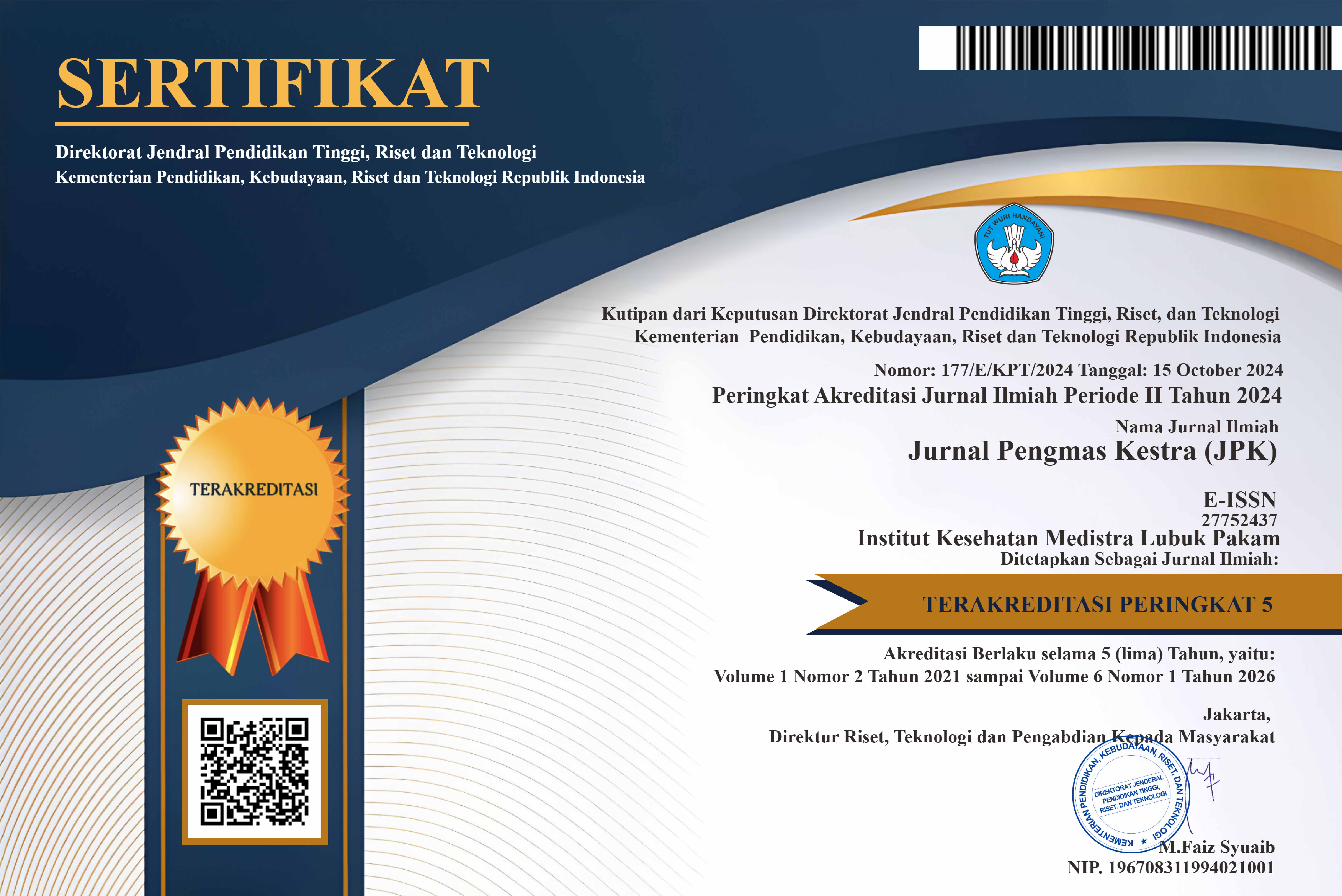Lower Back Pain Prevention Education In The Community In Sidodadi Village, Beringin District
DOI:
https://doi.org/10.35451/jpk.v4i1.2200Abstract
Low back pain (LBP) is characterized by pain, muscle tension, or stiffness localized below the ribs and above the crease of the buttocks, with or without leg pain. It can be categorized as non-specific LBP, a serious condition, or a radicular syndrome. Classifying LBP as acute (lasting less than 6 weeks), sub-acute (6 to 12 weeks), or chronic (more than 12 weeks) can aid in prognosis and guide management. Predictors of persistent disability from LBP include genetics, symptoms, lifestyle, social and psychological factors, and comorbidities. 7 However, no single risk factor is strongly predictive. The mechanisms of action of these risk factors are still unknown, but sleep disturbances and severe stress, for example, may lead to excessive activation of glial cells and thus to low-grade inflammation, leading to central sensitization, i.e. widespread pain. The implementation of community service activities was carried out through notification via the information platform at the village office with a sample of 15 residents in Sidodi Village, Beringin District. It is recommended that residents maintain their health, especially physically, so that, in addition, it is also recommended to continue to pay attention to or apply a healthy daily lifestyle and maintain their physical condition so that they remain healthy.
References
Negrini S, Zaina F. The chimera of low back pain etiology: a clinical rehabilitation perspective. Am J Phys Med Rehabil 2013;92:93–7.
Hoy D, Brooks P, Blyth F, Buchbinder R. The Epidemiology of low back pain. Best Pract Res Clin Rheumatol 2010;24:769–81
Meucci RD, Fassa AG, Faria NM. Prevalence of chronic low back pain: systematic review. Rev Saude Publica 2015;49:1.
Hartvigsen J, Hancock MJ, Kongsted A, Louw Q, Ferreira ML, Genevay S, et al.; Lancet Low Back Pain Series Working Group. What low back pain is and why we need to pay attention. Lancet 2018;391:2356–67
Brinjikji W, Diehn FE, Jarvik JG, Carr CM, Kallmes DF, Murad MH, et al. MRI Findings of Disc Degeneration are More Prevalent in Adults with Low Back Pain than in Asymptomatic Controls: A Systematic Review and Meta-Analysis. AJNR Am J Neuroradiol 2015;36:2394–9.
Negrini S, Zaina F, Romano M, Trevisan C. Rehabilitation of Lumbar Spine Disorders: An Evidence-Based Clinical Practice Approach. In: Frontera WR, DeLisa JA, Gans BM, Walsh NE, Robinson L, editors.
DeLisa’s Physical Medicine and Rehabilitation: Principles and Practice. Sixth edition. Baltimore, MD: Lippincott Williams & Wilkins; 2019
Zaina Fabio, et al, Low Back Pain in 2020: new frontiers and old limits of our understanding. An overview of the state of the art from a rehabilitation perspective, European Journal of Physical and Rehabilitation Medicine · March 2020
Depreitere B, Jonckheer P, Desomer A, Van Wambeke P. The pivotal role for the multidisciplinary approach at all phases and at all levels in the national pathway for the management of low back pain and radicular pain in Belgium. Eur J Phys Rehabil Med 2019
Maher C, Underwood M, Buchbinder R: Non-specific low back pain. Lancet. 2017, 389:736-47. 10.1016/S0140-6736(16)30970-9
Varrassi G, Moretti B, Pace MC, Evangelista P, Iolascon G: Common clinical practice for low back pain treatment: a modified Delphi study. Pain Ther. 2021, 10:589-604. 10.1007/s40122-021-00249-w
Downloads
Published
Issue
Section
License
Copyright (c) 2024 Siti Sarah Bintang Sarah Bintang, Sabirin Berampu, Raynald Ignasius Ginting, Dwi Handayani, Miftahul Jannah

This work is licensed under a Creative Commons Attribution 4.0 International License.
Copyright in each article is the property of the Author.




















